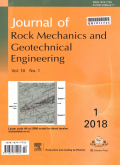- 钛学术文献服务平台 \
- 学术期刊 \
- 基础科学期刊 \
- 天文学、地球科学期刊 \
- 岩石力学与岩土工程学报(英文版)期刊 \
A novel true triaxial test system for microwave-induced fracturing of hard rocks
A novel true triaxial test system for microwave-induced fracturing of hard rocks
基本信息来源于合作网站,原文需代理用户跳转至来源网站获取
摘要:
This study introduces a test system for microwave-induced fracturing of hard rocks under true triaxial stress. The test system comprises a true triaxial stress loading system, an open-ended microwave-induced fracturing system, a data acquisition system, an acoustic emission (AE) monitoring system, and an auxiliary specimen loading system. Microwave-induced surface and borehole fracturing tests under true triaxial stress were fulfilled for the first time, which overcomes the problem of microwave leakage in the coupling loading of true triaxial stress and microwave. By developing the dynamic monitoring system, the thermal response and fracture evolution were obtained during microwave irradiation. The monitoring system includes the infrared thermometry technique for monitoring rock surface tempera-ture, the distributed optic fiber sensing technique for monitoring temperature in borehole in rock, the AE technique and two-dimensional digital speckle correlation technique for monitoring the evolution of thermal damage and the rock fracturing process. To validate the advantages of the test system and investigate the characteristics of microwave-induced fracturing of hard rocks, the study demonstrates the experimental methods and results for microwave-induced surface and borehole fracturing under true triaxial stress. The results show that thermal cracking presented intermittent characteristics (calm-active-calm) during microwave-induced surface and borehole fracturing of basalt. In addition, true triaxial stress can inhibit the development and distribution of thermal cracks during microwave-induced surface fracturing. When microwave-induced borehole fracturing occurs, it promotes the distribution of thermal cracks in rock, but inhibits the width of cracks. The results also prove the reliability of the test system.

推荐文章
Identification of bacterial fossils in marine source rocks in South China
South China
Excellent marine source rocks
Bacterial fossil
Sedimentary environment
The contribution of bacteria to organic matter in coal-measure source rocks
Coal-measure source rocks
Organic matter type
Bacteria
Monomethyl alkanes
Alkyl cyclohexane
Geochemistry and petrogenetic evolution of metasedimentary rocks in Bunu Area, part of Kabba-Lokoja-
Geochemical studies
Metasedimentary rocks
Geodynamic activities
Protolith
Passive continental margins
Distribution and geochemical significance of trace elements in shale rocks and their residual keroge
Shale
Kerogen
Trace elements
REEs
内容分析
关键词云
关键词热度
相关文献总数
(/次)
(/年)
文献信息
| 篇名 | A novel true triaxial test system for microwave-induced fracturing of hard rocks | ||
| 来源期刊 | 岩石力学与岩土工程学报(英文版) | 学科 | |
| 关键词 | |||
| 年,卷(期) | 2021,(5) | 所属期刊栏目 | |
| 研究方向 | 页码范围 | 961-971 | |
| 页数 | 11页 | 分类号 | |
| 字数 | 语种 | 英文 | |
| DOI | |||
五维指标
引文网络
引文网络
二级参考文献 (78)
共引文献 (23)
参考文献 (17)
节点文献
引证文献 (0)
同被引文献 (0)
二级引证文献 (0)
1965(2)
- 参考文献(0)
- 二级参考文献(2)
1968(1)
- 参考文献(0)
- 二级参考文献(1)
1971(2)
- 参考文献(0)
- 二级参考文献(2)
1972(2)
- 参考文献(0)
- 二级参考文献(2)
1973(1)
- 参考文献(0)
- 二级参考文献(1)
1974(1)
- 参考文献(0)
- 二级参考文献(1)
1975(1)
- 参考文献(0)
- 二级参考文献(1)
1978(1)
- 参考文献(0)
- 二级参考文献(1)
1980(1)
- 参考文献(1)
- 二级参考文献(0)
1984(2)
- 参考文献(0)
- 二级参考文献(2)
1987(1)
- 参考文献(0)
- 二级参考文献(1)
1990(1)
- 参考文献(0)
- 二级参考文献(1)
1991(3)
- 参考文献(0)
- 二级参考文献(3)
1992(1)
- 参考文献(0)
- 二级参考文献(1)
1993(1)
- 参考文献(0)
- 二级参考文献(1)
1994(3)
- 参考文献(0)
- 二级参考文献(3)
1995(1)
- 参考文献(0)
- 二级参考文献(1)
1997(1)
- 参考文献(0)
- 二级参考文献(1)
1998(1)
- 参考文献(0)
- 二级参考文献(1)
1999(1)
- 参考文献(0)
- 二级参考文献(1)
2000(3)
- 参考文献(1)
- 二级参考文献(2)
2002(2)
- 参考文献(0)
- 二级参考文献(2)
2003(1)
- 参考文献(0)
- 二级参考文献(1)
2004(3)
- 参考文献(0)
- 二级参考文献(3)
2005(1)
- 参考文献(0)
- 二级参考文献(1)
2006(2)
- 参考文献(1)
- 二级参考文献(1)
2007(3)
- 参考文献(0)
- 二级参考文献(3)
2010(4)
- 参考文献(1)
- 二级参考文献(3)
2012(2)
- 参考文献(0)
- 二级参考文献(2)
2013(1)
- 参考文献(0)
- 二级参考文献(1)
2014(3)
- 参考文献(1)
- 二级参考文献(2)
2015(6)
- 参考文献(0)
- 二级参考文献(6)
2016(11)
- 参考文献(3)
- 二级参考文献(8)
2017(7)
- 参考文献(3)
- 二级参考文献(4)
2018(6)
- 参考文献(1)
- 二级参考文献(5)
2019(9)
- 参考文献(2)
- 二级参考文献(7)
2020(3)
- 参考文献(3)
- 二级参考文献(0)
2021(0)
- 参考文献(0)
- 二级参考文献(0)
- 引证文献(0)
- 二级引证文献(0)
引文网络交叉学科
相关学者/机构
期刊影响力
岩石力学与岩土工程学报(英文版)
主办单位:
中国科学院武汉岩土力学所
中国岩石力学与工程学会
武汉大学
出版周期:
双月刊
ISSN:
1674-7755
CN:
42-1801/O3
开本:
大16开
出版地:
湖北省武汉市武昌区水果湖街小洪山2号
邮发代号:
38-299
创刊时间:
2009
语种:
eng
出版文献量(篇)
931
总下载数(次)
0
期刊文献
相关文献
推荐文献
- 期刊分类
- 期刊(年)
- 期刊(期)
- 期刊推荐
力学
化学
地球物理学
地质学
基础科学综合
大学学报
天文学
天文学、地球科学
数学
气象学
海洋学
物理学
生物学
生物科学
自然地理学和测绘学
自然科学总论
自然科学理论与方法
资源科学
非线性科学与系统科学
岩石力学与岩土工程学报(英文版)2022
岩石力学与岩土工程学报(英文版)2021
岩石力学与岩土工程学报(英文版)2020
岩石力学与岩土工程学报(英文版)2019
岩石力学与岩土工程学报(英文版)2018
岩石力学与岩土工程学报(英文版)2017
岩石力学与岩土工程学报(英文版)2016
岩石力学与岩土工程学报(英文版)2015
岩石力学与岩土工程学报(英文版)2014
岩石力学与岩土工程学报(英文版)2013
岩石力学与岩土工程学报(英文版)2012
岩石力学与岩土工程学报(英文版)2011
岩石力学与岩土工程学报(英文版)2010
岩石力学与岩土工程学报(英文版)2009
岩石力学与岩土工程学报(英文版)2021年第5期
岩石力学与岩土工程学报(英文版)2021年第4期
岩石力学与岩土工程学报(英文版)2021年第3期
岩石力学与岩土工程学报(英文版)2021年第2期
岩石力学与岩土工程学报(英文版)2021年第1期

 免费查重
免费查重










